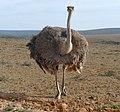 | The Eocene (IPA: /ˈiːəsiːn, ˈiːoʊ-/ EE-ə-seen, EE-oh-) is a geological epoch that lasted from about 56 to 33.9 million years ago (Ma). It is the second... 99 KB (11,044 words) - 02:47, 22 April 2024 |
sparsity of extant forms of molluscs. The Oligocene is preceded by the Eocene Epoch and is followed by the Miocene Epoch. The Oligocene is the third and... 70 KB (7,819 words) - 05:56, 30 April 2024 |
 | consists of the Paleocene, Eocene, and Oligocene epochs. The end of the Paleocene (56 Mya) was marked by the Paleocene–Eocene Thermal Maximum, one of the... 23 KB (2,374 words) - 17:57, 17 April 2024 |
 | Ypresian (redirect from Early Eocene) of the Eocene. It spans the time between 56 and 47.8 Ma, is preceded by the Thanetian Age (part of the Paleocene) and is followed by the Eocene Lutetian... 15 KB (1,334 words) - 08:07, 5 January 2024 |
 | warmer than today, particularly during the Paleocene–Eocene Thermal Maximum. However, the Eocene to Oligocene transition and the Quaternary glaciation... 34 KB (3,639 words) - 02:10, 27 April 2024 |
The Early Eocene Climatic Optimum (EECO), also referred to as the Early Eocene Thermal Maximum (EETM), was a period of extremely warm greenhouse climatic... 17 KB (1,856 words) - 04:15, 12 February 2024 |
Paleocene (section Paleocene–Eocene Thermal Maximum) palaiós meaning "old" and the Eocene Epoch (which succeeds the Paleocene), translating to "the old part of the Eocene". The epoch is bracketed by two... 153 KB (17,284 words) - 04:32, 22 April 2024 |
Eocene Thermal Maximum 2 (ETM-2), also called H-1 or Elmo (Eocene Layer of Mysterious Origin), was a transient period of global warming that occurred... 14 KB (1,529 words) - 04:37, 20 April 2024 |
Two immature specimens of polyxenidan millipedes are described from the Eocene Bitterfeld amber (Germany) by Haug et al. (2018). First known millipede... 175 KB (9,235 words) - 08:52, 7 March 2024 |
 | and Asia, died out at the beginning of the Upper Eocene. Equoidea (equines) also developed in the Eocene. Palaeotheriidae are known mainly from Europe;... 68 KB (7,204 words) - 07:55, 13 April 2024 |
 | Vasuki indicus (category Eocene snakes) Vasuki is an extinct genus of madtsoiid snake from the Middle Eocene Naredi Formation of India. The genus contains a single species, V. indicus, known... 8 KB (682 words) - 06:29, 28 April 2024 |
The Middle Eocene Climatic Optimum (MECO), also called the Middle Eocene Thermal Maximum (METM), was a period of very warm climate that occurred during... 23 KB (2,440 words) - 03:05, 19 February 2024 |
extinct genus of primate from the Eocene Nadu Formation of China. Living about 35 million years ago during the late Eocene, Palaeohodites belongs to an extinct... 13 KB (1,361 words) - 06:09, 29 April 2024 |
The paleofauna of the Eocene Okanagan Highlands consists of Early Eocene arthropods, vertebrates, plus rare nematodes and molluscs found in geological... 164 KB (7,784 words) - 18:10, 23 April 2024 |
 | Eocene Peak is a granitic summit with an elevation of 11,569 feet (3,526 m) located on the crest of the Sierra Nevada mountain range, in northern California... 5 KB (315 words) - 17:22, 28 March 2024 |
 | families are known, spanning across the Northern Hemisphere, from the Early Eocene to the early Pliocene, including a variety of flightless forms like the... 4 KB (328 words) - 01:11, 15 March 2024 |
 | family. The earliest fossil species of the family date back to the Late Eocene epoch, with earlier origins suspected. Colubrid snakes are found on every... 28 KB (2,221 words) - 00:51, 27 April 2024 |
the genus Protosiren representing the first sirenians reported from the Eocene (Bartonian) ornamental limestone from the Eastern Desert (Egypt). Vitek... 138 KB (14,401 words) - 18:41, 29 April 2024 |
the Eocene La Meseta Formation (Seymour Island, Antarctica), interpreted by the authors as likely apex predator of Antarctica during the Eocene. A study... 105 KB (10,557 words) - 02:11, 30 April 2024 |
 | years ago. Suina (including pigs) have been around since the Eocene. In the late Eocene or the Oligocene, two families stayed in Eurasia and Africa; the... 61 KB (6,271 words) - 02:06, 19 April 2024 |
 | Pakicetus (category Eocene mammals of Asia) family Pakicetidae, which was endemic to Pakistan during the Ypresian (early Eocene) period, roughly 50 million years ago. It was a wolf-like animal, about... 17 KB (1,722 words) - 13:34, 11 April 2024 |









